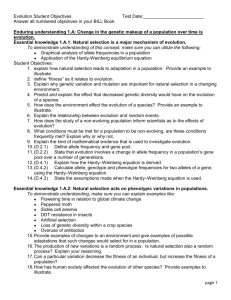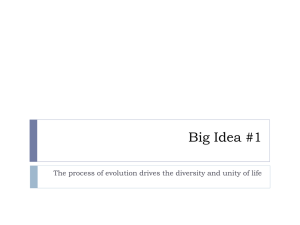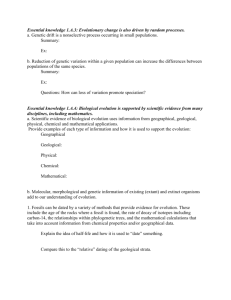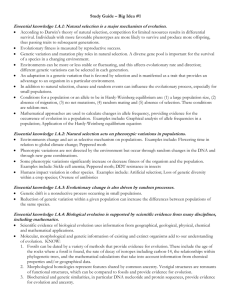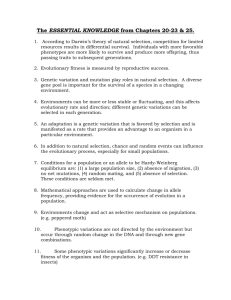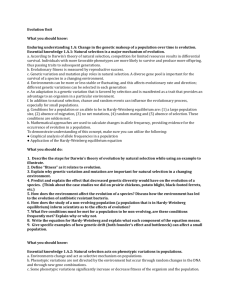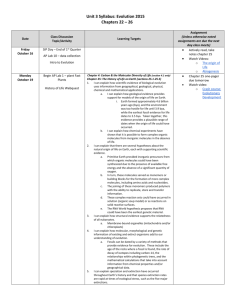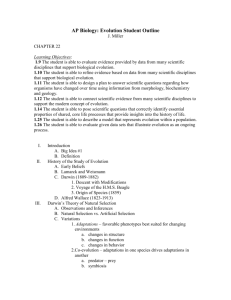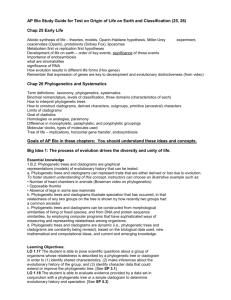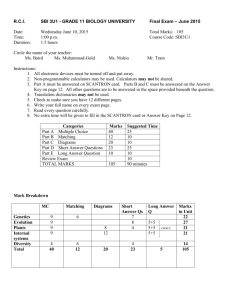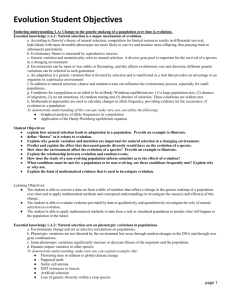Evo student Objectives
advertisement
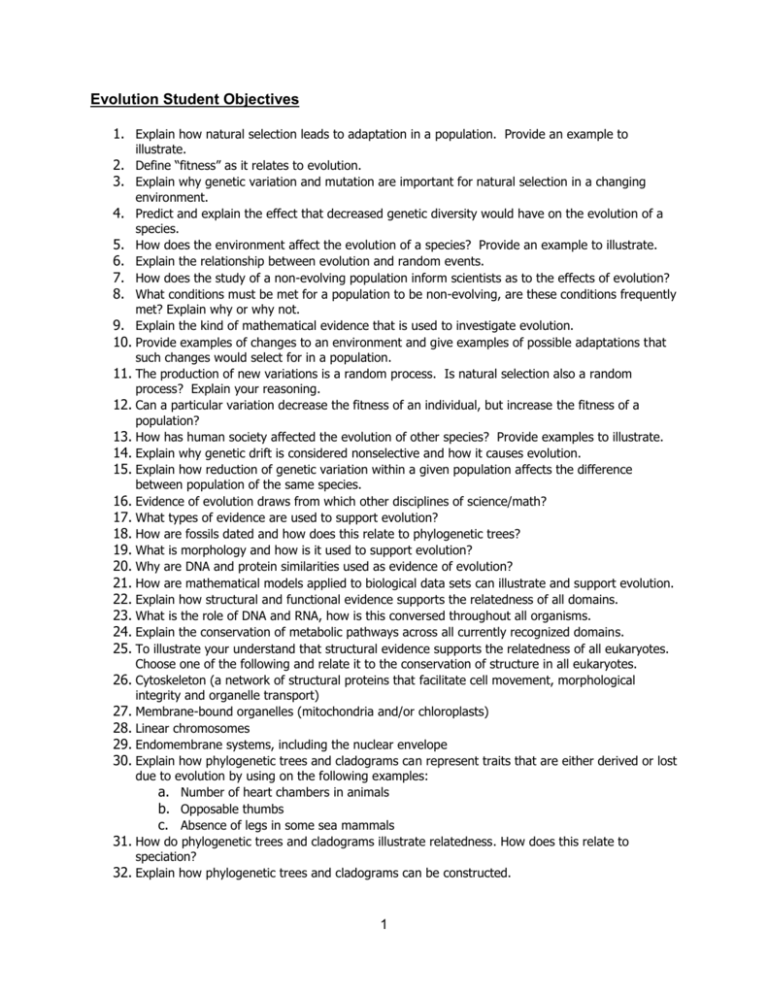
Evolution Student Objectives 1. Explain how natural selection leads to adaptation in a population. Provide an example to illustrate. 2. Define “fitness” as it relates to evolution. 3. Explain why genetic variation and mutation are important for natural selection in a changing environment. 4. Predict and explain the effect that decreased genetic diversity would have on the evolution of a species. How does the environment affect the evolution of a species? Provide an example to illustrate. Explain the relationship between evolution and random events. How does the study of a non-evolving population inform scientists as to the effects of evolution? What conditions must be met for a population to be non-evolving, are these conditions frequently met? Explain why or why not. 9. Explain the kind of mathematical evidence that is used to investigate evolution. 10. Provide examples of changes to an environment and give examples of possible adaptations that such changes would select for in a population. 11. The production of new variations is a random process. Is natural selection also a random process? Explain your reasoning. 12. Can a particular variation decrease the fitness of an individual, but increase the fitness of a population? 13. How has human society affected the evolution of other species? Provide examples to illustrate. 14. Explain why genetic drift is considered nonselective and how it causes evolution. 15. Explain how reduction of genetic variation within a given population affects the difference between population of the same species. 16. Evidence of evolution draws from which other disciplines of science/math? 17. What types of evidence are used to support evolution? 18. How are fossils dated and how does this relate to phylogenetic trees? 19. What is morphology and how is it used to support evolution? 20. Why are DNA and protein similarities used as evidence of evolution? 21. How are mathematical models applied to biological data sets can illustrate and support evolution. 22. Explain how structural and functional evidence supports the relatedness of all domains. 23. What is the role of DNA and RNA, how is this conversed throughout all organisms. 24. Explain the conservation of metabolic pathways across all currently recognized domains. 25. To illustrate your understand that structural evidence supports the relatedness of all eukaryotes. Choose one of the following and relate it to the conservation of structure in all eukaryotes. 26. Cytoskeleton (a network of structural proteins that facilitate cell movement, morphological integrity and organelle transport) 27. Membrane-bound organelles (mitochondria and/or chloroplasts) 28. Linear chromosomes 29. Endomembrane systems, including the nuclear envelope 30. Explain how phylogenetic trees and cladograms can represent traits that are either derived or lost due to evolution by using on the following examples: a. Number of heart chambers in animals b. Opposable thumbs c. Absence of legs in some sea mammals 31. How do phylogenetic trees and cladograms illustrate relatedness. How does this relate to speciation? 32. Explain how phylogenetic trees and cladograms can be constructed. 5. 6. 7. 8. 1 33. How does the biological data used, new mathematical and computational ideas, and current and emerging knowledge effect phylogenic trees and cladograms? 34. Explain how adaptive radiation and new habitats becoming available effects the speciation rate. 35. Explain how species extinction rates are rapid at times of ecological stress by applying the concept to one of the following examples. a. Five major extinctions b. Human impact on ecosystems and species extinction rates 36. Explain how speciation occurs, including allopatric, sympatric, and parapatric speciation. Be sure to discuss pre-and post-zygotic mechanisms that can maintain reproductive isolation and prevent gene flow. 37. What is the rate of most speciation, and how does polyploidy change the rate of speciation. 38. Describe the types of scientific evidence that supports the idea that evolution has occurred in all species. 39. Using an example below, describe the scientific evidence that supports the idea that evolution continues to occur. a. Chemical resistance (mutations for resistance to antibiotics, pesticides, herbicides or chemotherapy drugs occur in the absence of the chemical) b. Emergent diseases c. Observed directional phenotypic change in a population (Grants’ observations of Darwin’s finches in the Galapagos) d. A eukaryotic example that describes evolution of a structure or process such as heart chambers, limbs, the brain and the immune system 40. List the various hypotheses about the natural origin of life on earth with the scientific evidence that supports each model. 41. Discuss what was required of Primitive Earth for the synthesis of organic molecules 42. Identity what could have occurred to these newly synthesized organic molecules to further the development of earth. 43. Why are polymers with the ability to replicate, store and transfer information important to the origin of life. 44. Describe the organic soup model the solid reactive surfaces where these reactions could have occurred. 45. Explain the RNA World hypothesis 46. List the types of evidence that provides support for models of the origin of life on Earth. 47. Describe the timeline of the formation of the earth, the formation of life, and the evidence used to support this timeline. 48. Describe the chemical experiments that show that it is possible to form complex organic molecules from inorganic molecules in the absence of life. 49. Discuss the molecular and genetic evidence from extant and extinct organisms which indicates that all organisms on Earth share a common ancestral origin of life. 50. Identify the scientific evidence which includes molecular building blocks and common genetic code that are common to all life forms. 2
